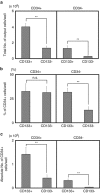CD133 is a positive marker for a distinct class of primitive human cord blood-derived CD34-negative hematopoietic stem cells
- PMID: 24189293
- PMCID: PMC4051213
- DOI: 10.1038/leu.2013.326
CD133 is a positive marker for a distinct class of primitive human cord blood-derived CD34-negative hematopoietic stem cells
Abstract
The identification of human CD34-negative (CD34(-)) hematopoietic stem cells (HSCs) provides a new concept for the hierarchy in the human HSC compartment. Previous studies demonstrated that CD34(-) severe combined immunodeficiency (SCID)-repopulating cells (SRCs) are a distinct class of primitive HSCs in comparison to the well-characterized CD34(+)CD38(-) SRCs. However, the purification level of rare CD34(-) SRCs in 18 lineage marker-negative (Lin(-)) CD34(-) cells (1/1000) is still very low compared with that of CD34(+)CD38(-) SRCs (1/40). As in the mouse, it will be necessary to identify useful positive markers for a high degree of purification of rare human CD34(-) SRCs. Using 18Lin(-)CD34(-) cells, we analyzed the expression of candidate positive markers by flow cytometric analysis. We finally identified CD133 as a reliable positive marker of human CB-derived CD34(-) SRCs and succeeded in highly purifying primitive human CD34(-) HSCs. The limiting dilution analysis demonstrated that the incidence of CD34(-) SRCs in 18Lin(-)CD34(-)CD133(+) cells was 1/142, which is the highest level of purification of these unique CD34(-) HSCs to date. Furthermore, CD133 expression clearly segregated the SRC activities of 18Lin(-)CD34(-) cells, as well as 18Lin(-)CD34(+) cells, in their positive fractions, indicating its functional significance as a common cell surface maker to isolate effectively both CD34(+) and CD34(-) SRCs.
Figures






Similar articles
-
[Updated human hematopoietic stem cell findings: purification of human hematopoietic stem cells and elucidation of their hierarchy].Rinsho Ketsueki. 2018;59(10):1861-1871. doi: 10.11406/rinketsu.59.1861. Rinsho Ketsueki. 2018. PMID: 30305486 Review. Japanese.
-
CD34 Antigen and the MPL Receptor Expression Defines a Novel Class of Human Cord Blood-Derived Primitive Hematopoietic Stem Cells.Cell Transplant. 2017 Jun 9;26(6):1043-1058. doi: 10.3727/096368916X694201. Epub 2016 Nov 30. Cell Transplant. 2017. PMID: 27938494 Free PMC article.
-
In vivo dynamics of human cord blood-derived CD34(-) SCID-repopulating cells using intra-bone marrow injection.Leukemia. 2010 Jan;24(1):162-8. doi: 10.1038/leu.2009.206. Epub 2009 Oct 1. Leukemia. 2010. PMID: 19798093
-
Development of a high-resolution purification method for precise functional characterization of primitive human cord blood-derived CD34-negative SCID-repopulating cells.Exp Hematol. 2011 Feb;39(2):203-213.e1. doi: 10.1016/j.exphem.2010.11.008. Epub 2010 Nov 26. Exp Hematol. 2011. PMID: 21112372
-
Human CD34-negative hematopoietic stem cells: The current understanding of their biological nature.Exp Hematol. 2021 Apr;96:13-26. doi: 10.1016/j.exphem.2021.02.004. Epub 2021 Feb 19. Exp Hematol. 2021. PMID: 33610645 Review.
Cited by
-
The Preconditioning of Busulfan Promotes Efficiency of Human CD133+ Cells Engraftment in NOD Shi-SCID IL2Rγcnull (NOG) Mice via Intra-Bone Marrow Injection.Cell Transplant. 2019 Jul;28(7):973-979. doi: 10.1177/0963689719842162. Epub 2019 Apr 15. Cell Transplant. 2019. PMID: 30983406 Free PMC article.
-
Deciphering the Complexities of Adult Human Steady State and Stress-Induced Hematopoiesis: Progress and Challenges.Int J Mol Sci. 2025 Jan 14;26(2):671. doi: 10.3390/ijms26020671. Int J Mol Sci. 2025. PMID: 39859383 Free PMC article. Review.
-
Molecular and phenotypic characterization of CD133 and SSEA4 enriched very small embryonic-like stem cells in human cord blood.Leukemia. 2015 Sep;29(9):1909-17. doi: 10.1038/leu.2015.100. Epub 2015 Apr 17. Leukemia. 2015. PMID: 25882698
-
Early Detection of Negative Smoking Impacts: Vascular Adaptation Deviation Based on Quantification of Circulated Endothelial Activation Markers.Vasc Health Risk Manag. 2021 Mar 23;17:103-109. doi: 10.2147/VHRM.S296293. eCollection 2021. Vasc Health Risk Manag. 2021. PMID: 33790567 Free PMC article.
-
Integrative Analysis of CD133 mRNA in Human Cancers Based on Data Mining.Stem Cell Rev Rep. 2019 Feb;15(1):23-34. doi: 10.1007/s12015-018-9865-2. Stem Cell Rev Rep. 2019. PMID: 30430389 Review.
References
-
- Krause DS, Fackler MJ, Civin CI, May WS. CD34: structure, biology, and clinical utility. Blood. 1996;87:1–13. - PubMed
-
- Ratajczak MZ. Phenotypic and functional characterization of hematopoietic stem cells. Curr Opin Hematol. 2008;15:293–300. - PubMed
-
- Dick JE. Stem cell concepts renew cancer research. Blood. 2008;112:4793–4807. - PubMed
-
- Morrison SJ, Weissman IL. The long-term repopulating subset of hematopoietic stem cells is deterministic and isolatable by phenotype. Immunity. 1994;1:661–673. - PubMed
Publication types
MeSH terms
Substances
LinkOut - more resources
Full Text Sources
Other Literature Sources
Medical
Research Materials
Miscellaneous

